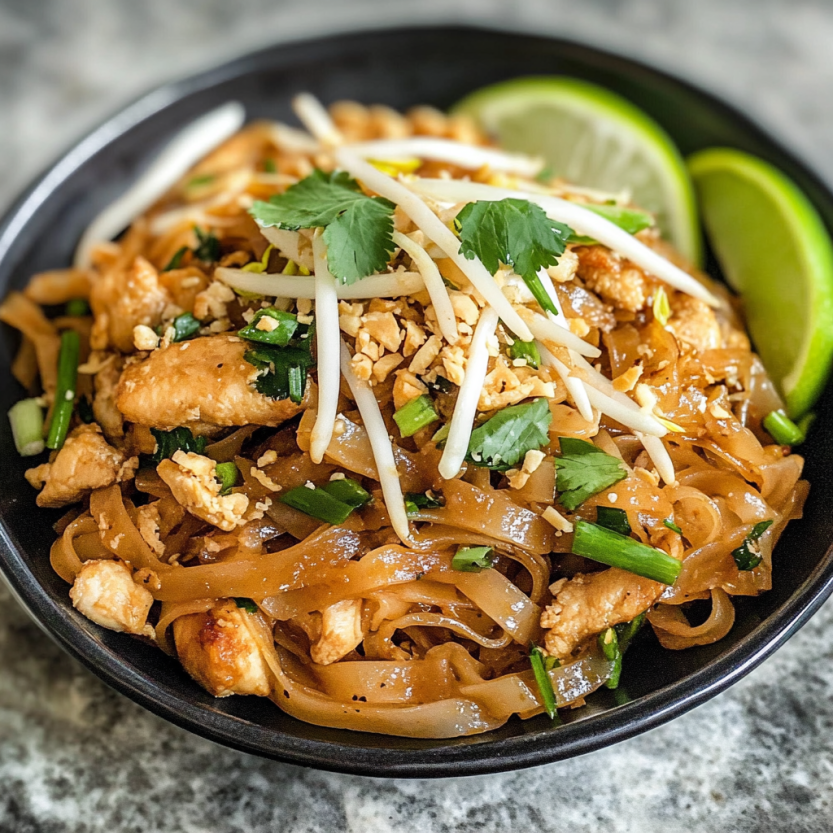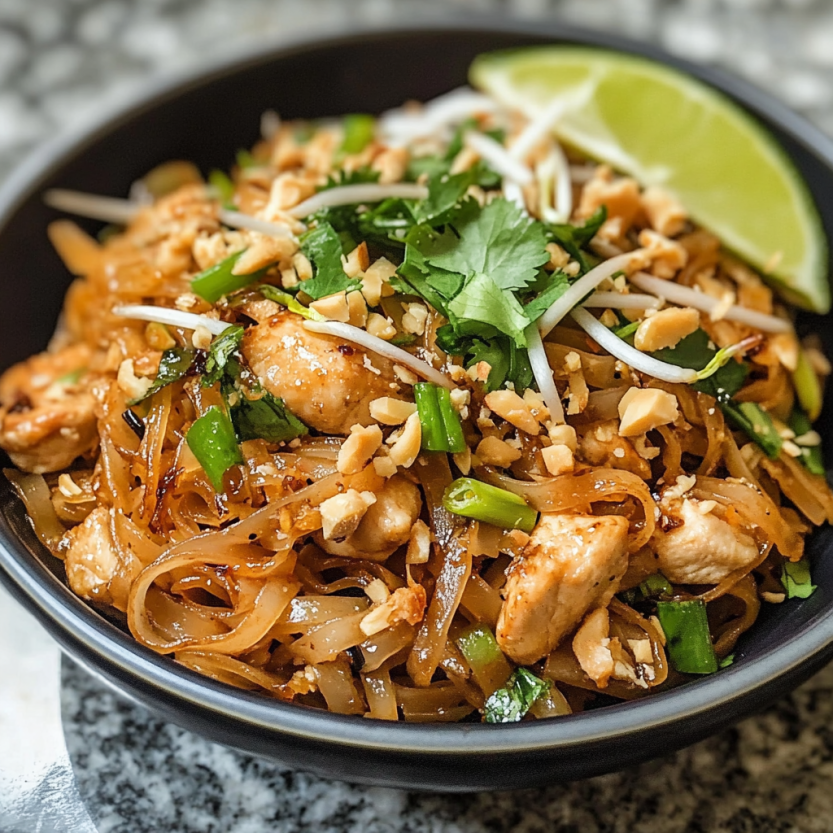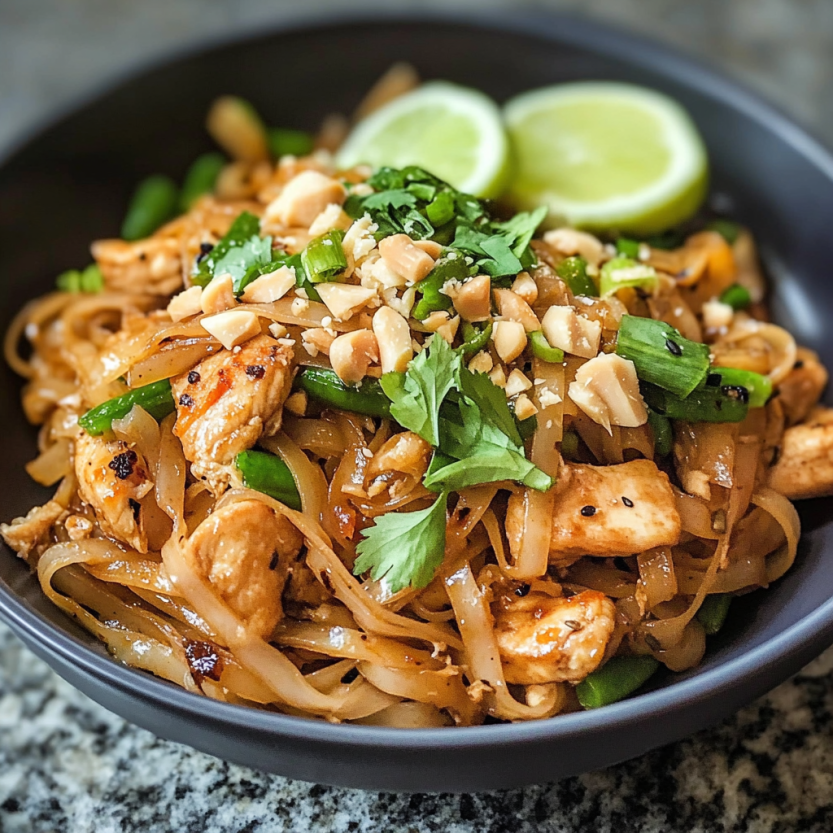 Bookmark
Bookmark
This authentic Chicken Pad Thai recipe transformed my family's takeout habits forever. The combination of sweet, savory, sour, and nutty flavors creates a restaurant-quality dish right in your own kitchen in just 25 minutes.
I discovered this recipe during a cooking class in Thailand and have perfected it over dozens of family dinners. My children now request it weekly instead of ordering takeout, which has saved us money and brought us closer through cooking together.
Ingredients
- Rice stick noodles: These wide, flat noodles create the authentic texture that makes Pad Thai so satisfying. Look for the large size variety for best results.
- Fish sauce: The foundational umami flavor that cannot be substituted. Choose a quality Thai brand for best results.
- Lime juice: Fresh squeezed provides brightness and acidity. Always use fresh rather than bottled for authentic flavor.
- Soy sauce: Adds depth and saltiness. I recommend low sodium varieties to better control the final salt level.
- Sriracha sauce: Provides customizable heat. You can adjust based on your spice preference.
- Brown sugar: Creates caramelization and balances the acidic and savory elements. Dark brown offers more depth.
- Chicken thigh: More flavorful and juicy than breast meat. Choose boneless skinless for convenience.
- Garlic: Essential aromatic foundation. Fresh cloves provide significantly better flavor than pre-minced options.
- Eggs: Creates richness and binds the dish. Room temperature eggs incorporate better.
- Tofu: Adds protein and texture variation. Choose firm variety for best results.
- Bean sprouts: Provides essential crunch and freshness. Look for crisp, white sprouts without discoloration.
- Peanuts: Delivers the signature nutty crunch. Dry roasted unsalted allows you to control seasoning.
Step-by-Step Instructions
- Prepare the sauce:
- Thoroughly mix fish sauce, lime juice, soy sauce, sriracha, and brown sugar in a small bowl until the sugar completely dissolves. This balanced sauce is the heart of authentic Pad Thai flavor.
- Soak the noodles:
- Submerge dry rice noodles in room temperature water for exactly 10 minutes until they become pliable but still firm in the center. They should be al dente as they will finish cooking in the pan.
- Cook the chicken:
- Preheat your oil in a large wok or deep skillet over medium high heat until it shimmers, about 2 minutes. Add diced chicken and minced garlic, stirring constantly to prevent burning while cooking for 3 minutes until chicken is nearly done but still juicy.
- Cook the noodles:
- Add your soaked noodles to the pan with the chicken and continuously stir for one full minute to begin the integration of flavors and continue cooking the noodles to the perfect texture.
- Add the eggs:
- Push all ingredients to one side of the pan, creating a clear space. Crack eggs directly into this space and let them cook until just set with no visible liquid remaining, then incorporate into the noodle mixture by folding and stirring for one minute.
- Combine with sauce:
- Pour your prepared sauce evenly over the noodle mixture and stir continuously for 1 minute to ensure even distribution. The sauce should begin to caramelize slightly and coat all ingredients.
- Add remaining ingredients:
- Turn heat to low and quickly add tofu, chives and bean sprouts. Gently but thoroughly stir for another minute to incorporate without overcooking the vegetables.
- Serve immediately:
- Sprinkle with chopped peanuts and transfer to serving plates right away while still hot to experience the optimal texture and flavor profile.
 Bookmark
Bookmark
The fish sauce is truly the secret ingredient here. When I first tried cooking this dish years ago, I attempted to substitute soy sauce and it was never quite right. Once I embraced real Thai fish sauce, the authentic flavor finally emerged. My daughter now calls this dish our special "no takeout night" tradition.
Texture Perfection
The key to outstanding Pad Thai lies in proper noodle texture. Many home cooks struggle with either undercooked rigid noodles or overcooked mushy ones. The two-stage cooking process soaking first, then finishing in the wok ensures perfect texture every time. Watch closely as the noodles transform from transparent to white, signaling they are fully cooked but still maintain their structure. This technique prevents the soggy disappointment that often happens with stir-fried noodles at home.
Make It Your Own
Pad Thai welcomes countless variations while maintaining its authentic character. Swap chicken for shrimp, tofu, or thinly sliced beef. Vegetarians can omit the fish sauce and use mushroom-based soy sauce for umami depth. Add extra vegetables like julienned carrots, bell peppers, or shredded cabbage for nutrition and color. For a peanut allergy-friendly version, substitute toasted sunflower seeds or cashews. The recipe remains authentic as long as you maintain the balance of sweet, sour, savory, and spicy elements in the sauce.
The Wok Hei Factor
Traditional Thai cooks achieve wok hei a specific charred flavor that comes from cooking over extremely high heat. While home kitchens rarely reach restaurant temperatures, you can approximate this effect by ensuring your pan is properly preheated before adding ingredients and working in small batches to maintain heat. Using a carbon steel wok rather than a non-stick pan also helps develop better flavor. The continuous stirring mentioned in the recipe is not just to prevent sticking it helps create those delicious caramelized bits that give authentic Pad Thai its complex flavor profile.
Meal Prep Strategy
Though best enjoyed immediately, you can prepare elements of this dish ahead of time. Mix the sauce and store refrigerated for up to three days. Chop all vegetables and store in separate containers. Even pre-soak the noodles, drain completely, and toss with a few drops of oil to prevent sticking, then refrigerate in an airtight container for up to 24 hours. With these preparations complete, final cooking takes just minutes making this perfect for busy weeknights when you need a quick but impressive meal.
 Bookmark
Bookmark
Frequently Asked Questions About Recipes
- → Can I use other proteins instead of chicken?
Yes, Pad Thai works wonderfully with other proteins. Try shrimp, thinly sliced beef, or tofu for a vegetarian version. For convenience, you can use ½ to 1 cup of rotisserie chicken instead of raw chicken - simply add it with the noodles as it's already cooked.
- → How do I prevent the noodles from getting mushy?
The key is not to overcook the noodles. Soak them according to package directions until just soft but still firm, then cook only until the sauce dries and the noodles turn from transparent to white. Lower the heat if you find things cooking too quickly, especially if you're new to stir-frying noodles.
- → Can I make Pad Thai ahead of time?
Pad Thai is best served immediately after cooking when the noodles have optimal texture and flavor. Once the noodles cool, they begin to lose their pleasant texture. If you need to prepare ahead, consider cooking the sauce and prepping all ingredients, then assemble and stir-fry just before serving.
- → How can I make vegetarian Pad Thai?
To make vegetarian Pad Thai, simply omit the chicken and replace the fish sauce with vegetarian fish sauce or more soy sauce with a touch of lime. You can add extra firm tofu or vegetables like bell peppers, carrots, and mushrooms for additional texture and flavor.
- → What if I can't find rice stick noodles?
If rice stick noodles aren't available, vermicelli noodles work as mentioned in the ingredients. In a pinch, you can also use rice noodles of different widths, though the texture will vary slightly. Avoid wheat noodles as they'll significantly change the authentic flavor and texture of the dish.
- → Why is my Pad Thai too dry or too wet?
The perfect Pad Thai has noodles that are coated in sauce but not swimming in liquid. If your dish is too dry, add a splash of water or a bit more sauce. If it's too wet, continue cooking until the excess moisture evaporates. The noodle-soaking time also affects final texture, so adjust accordingly next time.
